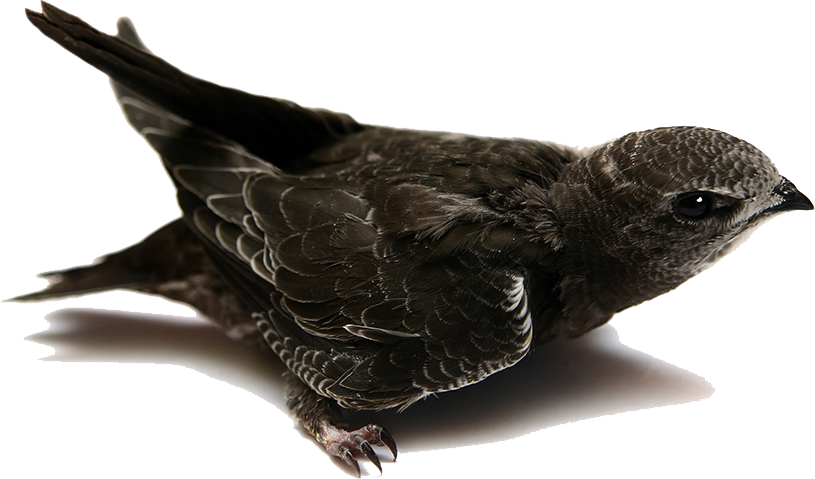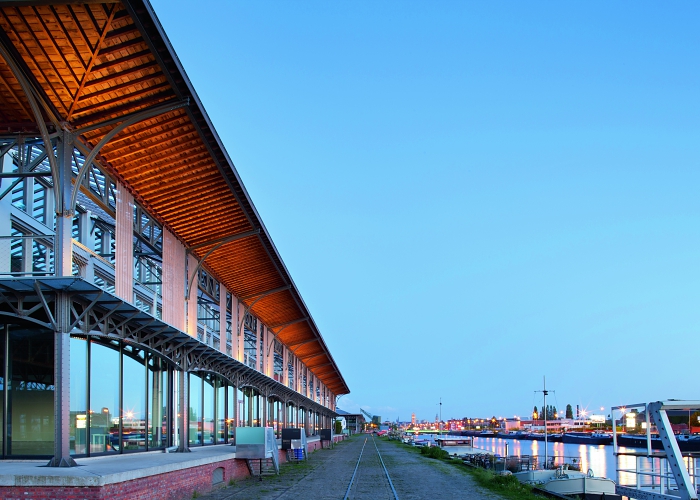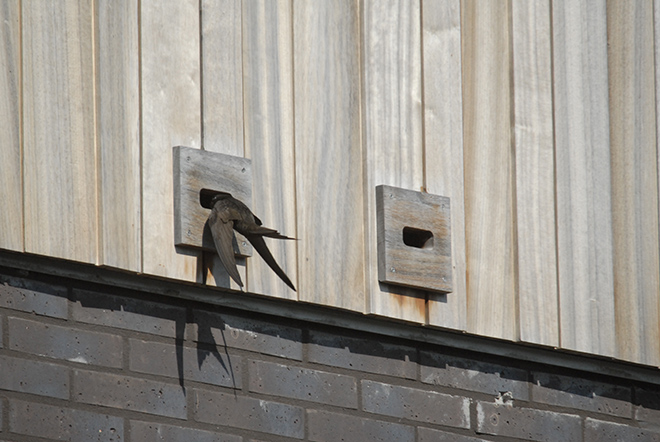
Eyes to the skies on the Voorhaven in Gent, Belgium
Stay tuned for next season…
From laying eggs to the first flight of the fledgelings: watch these short video summaries of three of last year’s nests to see what the swifts get up to over the full season!
Nestcam 1
Nestcam 2
Nestcam 3
Want to keep informed on the Voorhaven swifts? Sign up to our newsletter for occasional updates!
A swift summer
Note: dates are approximate estimates for the breeding season of the Voorhaven swifts in Belgium
The swift birds at a glance
Description
Although the common swift looks much like a swallow or a house martin, they are a distinct species with many unique features. The similarity between swifts and other aerial birds has evolved through convergent evolution, owing to the their predominantly airborne lifestyle. The adaptation to constant high-speed flight is what has given the swift its distinctive anchor-like silhouette: the shape of their wings, much like a boomerang, is highly aerodynamic. Though swallows and martins also have similar shapes, there are a few easy ways to tell swifts apart.
Firstly, swifts do not have large white patches on their undersides like the other two species. They also don’t perch on wires, due to their very small underdeveloped legs, and tend to feed at a much higher altitude than swallows and martins.
Finally, you can tell a swift apart by the sound it is making: where swallows and martins have fairly soft calls, swift vocalizations sound like loud, shrill screams!

Audio of common swift calls
| Scientific name | Apus apus |
| Size | Length 16-17 cm, Wingspan 42-48 cm |
| Weight | 36-50g |
| Appearance | Dark brown, cream chin and sickle-shaped profile |
| Diet | Flying insects and airborne spiders |
| Conservation status (IUCN) | Globally - Least concern Regionally - Amber (Red List) |
| Population | Globally: 95000000-165000000 EU: 38,200,000-65,000,000 |
Distribution map
From Africa to Europe and back
By Vardion, sourced at wiki-commons

| Breeding range | |
| Wintering range |
Perhaps one of the most fascinating things about common swifts is their predominantly airborne lifestyle. Swifts are migratory, flying thousands of kilometers each year to and from central Africa, where they spend their time feeding high above the grassy savannas. Swifts only ever stay a few months in Europe, where they nest and breed, before returning again to their southerly feeding grounds. Astoundingly, between taking off from their nest in Europe and returning again the following year, the swifts never once touch down. Like a fish through water, swifts spend their lives on the wing.
Swifts eat, sleep and even mate whilst soaring through the air at breakneck speeds. There are only a few birds that reach higher speeds than swifts, who can travel along at speeds around 112km/h. That is equivalent to over 30 meters per second! To achieve these high speeds, swifts make use of updrafts and wind currents, that carry them along faster than their wings alone could manage. It is these wind currents that swifts will “catch” and surf along each year on their long journeys to and from their natal colonies in Europe, regularly covering over 200.000 kilometers in a year.

Threats
Common swifts are seen as symbols of urban life due to their propensity for nesting in man-made buildings. Unfortunately, many birds these days are struggling to find nest sites as buildings have become increasingly “swift proof”. For centuries, our buildings have had plenty of nooks and crannies for the birds to raise their families, but modern architecture has made our roofs and awnings too impenetrable: it has been estimated that less than 1% of modern buildings are able to accommodate swift nests. Additionally, old buildings are regularly knocked down to make room for new ones, meaning swifts arrive back from their long journeys only to discover they have been left homeless. As a result, swift populations have been in drastic decline in several areas around Europe. In the UK, common swifts are listed on the IUCN’s Amber Alert List of threatened species, as their population has been halved in the past 20 years.
There is good news however: there are ways to help! Organizations around the world are raising awareness for the plight of the common swift and are providing several practical solutions. One of the simplest changes you can make, as a home owner or a builder/architect, is to incorporate swift nest boxes into your building design. These boxes are about the size of a shoebox and can be either built into the walls or attached to the outside of a house. They are cheap, durable, and will provide swifts with a place to care for their families without worrying about sudden eviction. And what’s more: you reap all the benefits of a free bug extermination service!

Voorhaven project
Our Belgian birds
 A whole colony of common swifts have found a new home and friendly neighbors just north of Ghent city, Belgium. The Voorhaven area, where the colony has settled, is one of Europe’s best preserved nineteenth century harbors, with stunning monuments and warehouses. A local organization, De VZW Voorhaven, has taken it upon themselves to protect the heritage listed site, sharing their love for the area with visitors and educating people on the history and significance of the old buildings.
A whole colony of common swifts have found a new home and friendly neighbors just north of Ghent city, Belgium. The Voorhaven area, where the colony has settled, is one of Europe’s best preserved nineteenth century harbors, with stunning monuments and warehouses. A local organization, De VZW Voorhaven, has taken it upon themselves to protect the heritage listed site, sharing their love for the area with visitors and educating people on the history and significance of the old buildings.
In the 1990s, a native Voorhaven business called Locus began renovating the 19th century warehouses and later introduced several new buildings, incorporating sustainability and environmental design.
Locus always includes green projects in their building plans, such as solar panels, green roofs and nest boxes, and are passionate about sustainability and environmentally friendly urban design. They are currently working towards full climate neutrality for the entire Voorhaven area (3.5ha). About ten years ago, the CEO of Locus, Dirk Valvekens, had twenty swift nest boxes installed in one of the new building projects at the Voorhaven. These luxe bird penthouses were an instant hit, and over the next few years all twenty ended up inhabited by happy swift couples. The birds return each year to the same boxes to raise their next brood; Locus has even had to install more nest boxes on neighboring rooftops to keep up with demand!
This year Locus financed the development of the Voorhaven swift nest box website, to raise awareness for the plight of the swifts and for the area in which they reside. The nest box cameras were set up both to give the public a chance to see these stunning birds up close and to enable research into their fascinating and secretive lives. Locus believes that through community projects, such as this one, wildlife and green spaces can become a meaningful part of our urban neighborhoods. We can make a real difference to our environment, and “make our city smile”.
20
Research
Collaboration

A Voorhaven swift returning to its nest box
Collaboration is key to any success story. In the case of the Voorhaven swift project, our success is tied to our work with swift expert Lyndon Kearsley. Internationally renowned, Kearsley has dedicated his life to studying this fascinating and elusive species. His past work at the Voorhaven includes tracking swift habits by ringing birds (attaching metal bands to their legs for identification) as well as fitting individual birds with geo-locators to track their migration to and from Africa.
Migration

Lyndon Kearsley releasing a swift
Future collaboration with researchers such as Kearsley will allow the Voorhaven swift project to expand our knowledge of these charismatic birds, ultimately aiding conservation efforts for swifts everywhere. By studying swifts, we educate ourselves about how best to co-exist with wildlife in our cities and towns. Swifts have made it easy for us: they adopted human dwellings a long time ago as their preferred residences. Hopefully by learning how and why, we can encourage more wildlife into our cities, creating green spaces for all to enjoy!

